Zastakljenje, solarni dobici i senčenje
Glazing, Solar Gains, and Shading
U umerenijim klimatskim uslovima kao što su delovi južne Evrope, standard NZEB moguće je postići dvostrukim staklom dobrog kvaliteta. U ostatku Evrope, međutim, zgrade NZEB moraju da koriste trostruko zastakljene prozore; postoje dva glavna razloga za to:
In temperate climates such as parts of southern Europe, the NZEB standard can be achieved with good quality double glazing. However, in the rest of Europe, NZEB buildings must use triple glazed windows; there are two main reasons for this:
- da bi se smanjili neželjeni gubici toplote kroz prozor
- da bi se povećala temperatura unutrašnje površine prozora čime se smanjuje osećaj neugodnosti i mogućnosti rasta buđi.
- to reduce unwanted heat loss through the window
- to increase the temperature of the interior window surface, thereby reducing discomfort and the potential for mold growth.
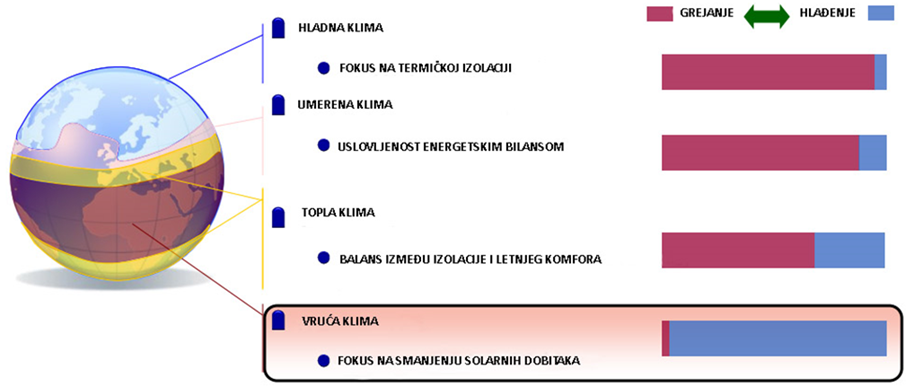
Zastakljivanje pogodno za upotrebu u zgradi NZEB trebalo bi da bude nezavisno sertifikovano kako bi se potvrdilo da standardna jedinica za zastakljenje (1,24 x 1,48m) ima U w vrednost za ceo prozor ≤ 0,80 W/m²K i može da postigne vrednost U ≤ 0,85 W/m²K kada se ugradi. Zastakljene komponente vrata moraju postići sličnu specifikaciju zastakljenja, a ugrađena U vrednost NZEB vrata trebala bi biti ≤ 0,80 W/m²K.
Glazing suitable for use in an NZEB building should be independently certified to confirm that a standard glazing unit (1.24 x 1.48m) has a Uw value for the entire window of ≤ 0.80 W/m²K and can achieve a U value of ≤ 0.85 W/m²K when installed. Glazed components of doors must achieve a similar glazing specification, and the installed U value of NZEB doors should be ≤ 0.80 W/m²K.
Solarni dobici i zastakljenje
Solar Gains and Glazing
Solarni dobici čine značajnu komponentu besplatnih dobitaka toplote dostupnih objektu tokom grejne sezone. Da bi se optimalno iskoristili korisni solarni dobici zimi, pored dobre orijentacije, zastakljenje mora da ima niske instalirane vrednosti Uw (≤ 0,85 W/m²K) da bi se smanjili toplotni gubici i dobru propusnost sunčevog zračenja (g-vrednosti ≥ 0,5). Suprotno, preveliko zastakljenje može dovesti do pregrevanja leti, pa je dobro oblikovanje sezonskog zasenčenja važno u NZEB dizajnu. Potrebno je posvetiti pažnju na senku od visokog ugla letnjeg sunca, posebno na južnim, zapadnim i istočnim fasadama. Da bi se postigle maksimalne performanse, specifikacije za zastakljenje i zasenčenje treba fino prilagoditi na svakoj fasadi zgrade.
Solar gains form a significant component of the free heat gains available to a building during the heating season. To optimally utilize beneficial solar gains in winter, besides good orientation, glazing must have low installed Uw values (≤ 0.85 W/m²K) to reduce heat losses and good solar radiation transmission (g-values ≥ 0.5). Conversely, excessive glazing can lead to overheating in summer, so good seasonal shading design is important in NZEB design. Attention needs to be paid to the shade provided by high-angle summer sun, particularly on south, west, and east facades. To achieve maximum performance, glazing and shading specifications should be finely tuned for each building facade.

Stoga je u pasivnoj kući potrebno u potpunosti iskoristiti dvostruku funkciju prozora: učestvovanje u efikasnosti termičkog omotača smanjujući toplotne gubitke i osiguravanje adekvatnih toplotnih dobitaka od sunčevog zračenja. Prva funkcija se vrši dobrim izolacionim karateristikama prozora, a druga, prema vrsti izlaganja sunčevim zracima i vrsti zastakljenja dozvoljavanjem ili onemogućavanjem dobitaka toplote proizvedene sunčevim zračenjem.
Therefore, in a passive house, it is necessary to fully utilize the dual function of windows: participating in the efficiency of the thermal envelope by reducing heat losses and ensuring adequate heat gains from solar radiation. The first function is performed by good insulating characteristics of the windows, and the second, depending on the type of exposure to solar rays and the type of glazing, by allowing or preventing heat gains generated by solar radiation.
Za verifikaciju performansi prozora, pored dimenzionalnih parametara, zahtevaju se i sledeći energetski parametri:
To verify window performance, in addition to dimensional parameters, the following energy parameters are required:
- solarni faktor stakla g označava odnos između ukupne toplotne energije koja se prenosi sa stakla i one koja pada na nju: kapaciteta stakla da smanji ili ublaži toplotne dobitke proizvedene sunčevim zračenjem. Vrednost g je direktno proporcionalna toplotnim dobicima: visoke g vrednosti omogućavaju velike dobitke i obrnuto.
- vrednost U g označava koeficijent prolaza toplote stakla.
- vrednost U f označava koeficijent prolaza toplote rama.
- vrednost ψ ivica zastakljenja (W/mK UNI TS 11300) je linijski koeficijent u odnosu na toplotni most ivice stakla, prouzrokovan promenom toplotnog toka koji prelazi tačku kontakta između stakla i okvira, uglavnom zbog odstojnika (u čeliku, aluminijumu ili plastici) koji razdvaja staklene ploče.
- vrednost Ѱ ugradnja , je linijski koeficijent toplotnog mosta nastao kao posledica ugradnje prozora, prouzrokovan promenom toplotnog toka koji prelazi tačku dodira između okvira i zida.
- The solar factor of the glass g indicates the ratio between the total heat energy transmitted through the glass and the energy falling on it: the glass's capacity to reduce or mitigate heat gains generated by solar radiation. The g value is directly proportional to heat gains: high g values allow significant gains and vice versa.
- The U g value indicates the heat transfer coefficient of the glass.
- The U f value indicates the heat transfer coefficient of the frame.
- The ψ edge value of the glazing (W/mK UNI TS 11300) is the linear coefficient concerning the heat bridge at the glass edge, caused by the change in heat flow passing through the contact point between the glass and the frame, mainly due to spacers (in steel, aluminum, or plastic) separating the glass panes.
- The Ѱ installation value is the linear coefficient of the heat bridge resulting from window installation, caused by the change in heat flow passing through the contact point between the frame and the wall.
Vrednost Uw nije potrebna jer se izračunava pomoću gore navedenih vrednosti.
The Uw value is not required as it is calculated using the above values.
Zaptivenost okvira, kako bi se ispunio zahtev n50 = 0,6 V/h, zavisi od dva faktora:
Frame sealing, to meet the requirement of n50 = 0.6 V/h, depends on two factors:
- nepropusnost između pomičnih i fiksnih okvira prozora
- zaptivanje između prozora i zida
- sealing between movable and fixed window frames
- sealing between the window and the wall
Prvi zahtev je određen EN 12207, koji definiše pet klasa propustljivosti vazduha: od 0 do 4. Najbolja je klasa 4, koja identifikuje okvir sa odličnom nepropusnošću; moguće je prepoznati klasu okvira prozora ili vrata kroz tehničku specifikaciju proizvoda. Drugi zahtev zavisi od pravilne ugradnje, korišćenja zaptivnih traka koje se šire i pogodne lepljive trake kako bi se osigurala nepropusnost između okvira i zida. Svi problemi ugradnje mogu se otkriti “blower door” testom i rešiti primenom zaptivnih traka ili mehaničkim učvrćivanjem okvira.
The first requirement is defined by EN 12207, which defines five classes of air permeability: from 0 to 4. The best is class 4, which identifies a frame with excellent airtightness; it is possible to recognize the class of the window or door frame through the product's technical specification. The second requirement depends on proper installation, using expanding sealing tapes and suitable adhesive tapes to ensure airtightness between the frame and the wall. All installation issues can be detected with a "blower door" test and resolved by applying sealing tapes or mechanical frame fastening.
Termički kvalitet stakla
Thermal Quality of Glass
| Niskoenergetski prozori: dvostruko zastakljenje, čija je U vrednost u rasponu od 1,1-1,5 W/m²K i koeficijent propustanja svetlosti od približno 60%. | Ova vrsta prozora je manje ili više energetski neutralna kada se postavi na južnu stranu zgrade, što znači da je solarni dobitak približno isti kao i gubitak. Ako se postavi na bilo koje drugo mesto, ova vrsta stakla gubi više energije nego što dobije. Zbog toga se preporučuje izbegavanje niskoenergetskih prozora kada se radi sa pasivnim dizajnom, naročito u predelima koji tokom zime dobijaju manje sati sunca dnevno. |
| Low-energy windows: double glazing with a U value ranging from 1.1-1.5 W/m²K and a light transmission coefficient of approximately 60%. | This type of window is more or less energy neutral when placed on the south side of the building, meaning that the solar gain is approximately equal to the loss. If placed anywhere else, this type of glass loses more energy than it gains. Therefore, it is recommended to avoid low-energy windows when dealing with passive design, especially in areas that receive fewer hours of sunlight during the winter. |
| Prozori izuzetno visokih performansi: trostruko zastakljenje, čija je U vrednost u opsegu od 0,5-0,7 W/m²K i koeficijent propustanja svetlosti od 50-60%. | Kada se koriste u saradnji sa super izolovanim okvirima, ovi prozori mogu da olakšaju dobijanje solarne toplote. Tokom hladnih ili oblačnih dana ili preko noći, prozor koji koristi ovu vrstu stakla izgubiće manje energije nego što može da apsorbuje u sunčanim periodima. Povećanje udela stakla ovog kvaliteta na južnoj strani podstaći će pasivniji solarni dobitak. |
| High-performance windows: triple glazing with a U value ranging from 0.5-0.7 W/m²K and a light transmission coefficient of 50-60%. | When used in conjunction with super insulated frames, these windows can facilitate solar heat gain. During cold or cloudy days or at night, a window using this type of glass will lose less energy than it can absorb during sunny periods. Increasing the share of this quality glass on the south side will encourage more passive solar gain. |
Termički kvalitet rama
Thermal Quality of Frames
| Uobičajeni ram od drveta ili vinila | Obično ima U vrednost između 2,0-2,5 W/m²K. Ovo su najčešće korišćene. |
| Metalni ili aluminijumski okviri | Iako su čvrsti, ovi materijali imaju visoku toplotnu provodljivost - aluminijum može da smanji izolacionu vrednost prozora za 20 do 30 procenata. Ovi okviri, u kombinaciji sa prozorima sa trostrukim oknima, dostigli bi maksimalnu U vrednost od 1,6-2,0 W/m²K, čak i sa ugrađenim toplotnim prekidima. |
| Drveni okviri | Dobar je izolator, ali zahteva više održavanja nego aluminijum. Drvo korišćeno za njihovu proizvodnju treba dobiti iz održive šume. |
| Kompozitni okviri | Vanjski profili od aluminijuma sa unutrašnjim presekom od drveta ili PVC. |
| Super izolovani okviri | Može se sastojati od drveta ili kompozitnog materijala od drveta/metala koji je izdubljen i ispunjen penom ili nekim drugim oblikom izolacije. Ove vrste okvira mogu dostići U-vrednosti ispod 0,8 W/m²K. |
| Common wood or vinyl frame | Typically has a U value between 2.0-2.5 W/m²K. These are the most commonly used. |
| Metal or aluminum frames | Although strong, these materials have high thermal conductivity - aluminum can reduce the insulating value of the window by 20 to 30 percent. These frames, combined with triple-glazed windows, would reach a maximum U value of 1.6-2.0 W/m²K, even with built-in thermal breaks. |
| Wooden frames | Good insulators, but require more maintenance than aluminum. Wood used for their production should be sourced from sustainable forests. |
| Composite frames | External profiles of aluminum with an internal cross-section of wood or PVC. |
| Super insulated frames | May consist of wood or composite material of wood/metal that is hollowed out and filled with foam or some other form of insulation. These types of frames can achieve U-values below 0.8 W/m²K. |
Preduslov za postizanje dobrih performansi prozora je super izolovani okvir.
The prerequisite for achieving good window performance is a super insulated frame.
Instaliranje visokoefikasnog trostrukog stakla u običan ram bilo bi neefikasno. Čak i ako se koristi super izolovani okvir, on je najslabija karika koja isporučuje skoro nikakav solarni dobitak istovremeno stvarajući toplotne mostove. Drugim rečima, prozori su uvek izvor gubitka energije.
Installing high-efficiency triple glazing in a standard frame would be ineffective. Even if a super insulated frame is used, it is the weakest link, delivering almost no solar gain while creating thermal bridges. In other words, windows are always a source of energy loss.
- Upotrebljavati visokoefikasno zastakljenje i okvir kako bi se smanjila količina energije izgubljene kroz prozore.
- Izaberite vrste prozora sa postojanim zaptivačima
- Imati na umu da je ova strategija važna, jer je veliki procenat gubitka energije u kući povezan sa prozorima.
- Use high-efficiency glazing and frames to minimize the amount of energy lost through windows.
- Choose window types with durable seals
- Keep in mind that this strategy is important, as a large percentage of energy loss in a home is associated with windows.
Zasenčenje
Shading
Odgovarajuća upotreba zasenčenja može sprečiti da previše toplote uđe u zgradu zaštićivanjem stakla od direktne sunčeve svetlosti. Ovo je posebno važno za južnu orijentaciju objekta tokom toplih letnjih meseci. Strategije zasenčenja mogu uključivati korišćenje nadstrešnica, terasa, žaluzina i brisoleja za regulaciju sunčevog pristupa.
Proper use of shading can prevent too much heat from entering the building by protecting the glass from direct sunlight. This is especially important for the southern orientation of the building during hot summer months. Shading strategies can include using awnings, terraces, blinds, and brise-soleils to regulate sun access.
Pasivno zasenčenje prozora
Passive Window Shading
Zavese se mogu koristiti za poboljšanje performansi postojećih prozora, ali nisu ni efikasne ni efektivne, jer se solarni dobitak toplote već nalazi unutar omotača zgrade. Roletne (venecijaneri) mogu uticati na smanjenje odsjaja, ali takođe nisu efikasne u sprečavanju solarnih toplotnih dobitaka. Spoljašnje zasenčenje, poput automatizovanih roletni, nije zaista pasivno jer troši energiju, materijale i resurse u svojoj proizvodnji. Takođe uključuju radne delove koji su podložni kvarovima.
Curtains can be used to improve the performance of existing windows, but they are neither efficient nor effective, as the solar heat gain is already within the building envelope. Blinds (venetian blinds) can reduce glare, but they are also ineffective in preventing solar heat gains. External shading, such as automated shutters, is not truly passive as it consumes energy, materials, and resources in its production. They also include moving parts that are prone to failure.
Tri načina prenosa toplote (kondukcija, konvekcija i zračenje) igraju značajnu ulogu u performansama prozora i njihova interakcija je šematski prikazana na slici.
The three modes of heat transfer (conduction, convection, and radiation) play a significant role in window performance and their interaction is schematically shown in the image.
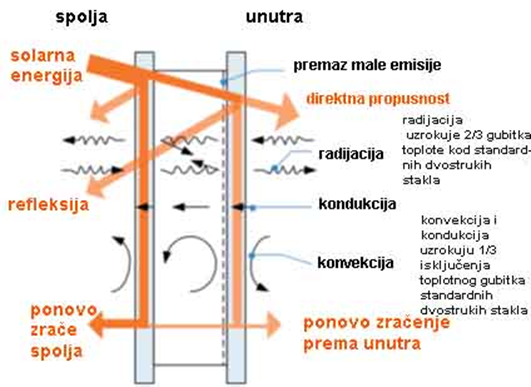
Toplota se kreće od toplijeg ka hladnijem telu, tako da su tokovi konvekcije i kondukcije pretežno iz unutrašnjosti ka spoljašnjosti objekta tokom većeg dela godine u srednjoj i severnoj Evropi. Suprotno tome, kad god je temperatura spoljne površine veća od temperature unutrašnje površine, smer ovih toplotnih tokova će se menjati. Kondukcijske i konvekcijske komponente prenosa energije kroz sistem zastakljenja uračunate su u U vrednosti prozora (Uw). Zračenje teče u skladu sa zakonima koji regulišu crna i siva tela, a koji navode da je brzina prenosa toplote po jedinici vremena (W) proporcionalna četvrtom stepenu apsolutne temperature tela (K) pomnoženo sa njegovom površinom (m2) prema jednačini Stefana – Boltmanna.
Heat moves from a warmer to a cooler body, so convection and conduction flows are predominantly from the interior to the exterior of the building for most of the year in central and northern Europe. Conversely, whenever the temperature of the outer surface is higher than the temperature of the inner surface, the direction of these heat flows will change. The conduction and convection components of energy transfer through the glazing system are accounted for in the window's U value (Uw). Radiation flows according to the laws governing black and gray bodies, which state that the rate of heat transfer per unit time (W) is proportional to the fourth power of the body's absolute temperature (K) multiplied by its area (m2) according to the Stefan-Boltzmann equation.
j = ε · σ · T4
j = ε · σ · T4
- j je emisiona moć apsolutnog crnog tela (W/m2)
- ε je emisivnost tela koje zrači
- σ je Štefan-Bolcmanova konstanta (5.67 × 10–8) W/m2K4
- T apsolutna temperatura emitujućeg tela (K)
- j is the emissive power of a perfect black body (W/m2)
- ε is the emissivity of the radiating body
- σ is the Stefan-Boltzmann constant (5.67 × 10–8) W/m2K4
- T is the absolute temperature of the emitting body (K)
Da bi se izračunala ukupna snaga (P) zračena od objekta j se množi sa površinom objekta (A).
To calculate the total power (P) radiated by the object, j is multiplied by the object's surface area (A).
Stoga, bez obzira na temperaturu spoljnjeg vazduha, toplota se može prenositi kroz ostakljene komponente direktnim ili indirektnim solarnim zračenjem. Udeo korisnog toplotnog dobitka koji se zračenjem ostakljenoj komponenti prenosi opisuje se koeficijentom solarnog toplotnog dobitka ili g-vrednosti stakla. Tipične g-vrednosti za jednostruko, dvostruko i trostruko zastakljenje mogu se naći u tabeli.
Therefore, regardless of the outdoor air temperature, heat can be transferred through glazed components by direct or indirect solar radiation. The share of useful heat gain transferred by radiation to the glazed component is described by the solar heat gain coefficient or g-value of the glass. Typical g-values for single, double, and triple glazing can be found in the table.
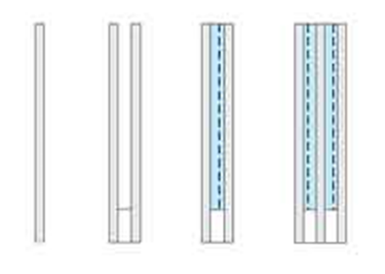
| Tip zastaklenja | Jednostruko zastakljenje | Dvostruko zastakljenje punjeno sa vazduhom | Dvostruko zastakljenje punjeno sa gasom sa premazom | Trostruko zastakljenje punjeno sa gasom sa premazom |
| odstojnik | bez | Nerđajući čelik | Topli odstojnik | Topli odstojnik |
| Uw | 5,6 | 2,80 | 1,20 | 0,65 |
| Unutrašnja temperatura | -1,8°C | 9,1 | 15,3 | 17,5 |
| g | 0,92 | 0,80 | 0,62 | 0,48 |
| Type of Glazing | Single Glazing | Double Glazing Filled with Air | Double Glazing Filled with Gas with Coating | Triple Glazing Filled with Gas with Coating |
| Spacer | None | Stainless Steel | Warm Spacer | Warm Spacer |
| Uw | 5.6 | 2.80 | 1.20 | 0.65 |
| Internal Temperature | -1.8°C | 9.1°C | 15.3°C | 17.5°C |
| g | 0.92 | 0.80 | 0.62 | 0.48 |
Radijativni prenos
Radiative Transfer
U kontekstu zgrada, radijativni prenos može se podeliti u dve podkategorije: kratkotalasni (<2,5 µm) i dugotalasni (> 8 <14 µm).
In the context of buildings, radiative transfer can be divided into two subcategories: shortwave (<2.5 µm) and longwave (> 8 <14 µm).
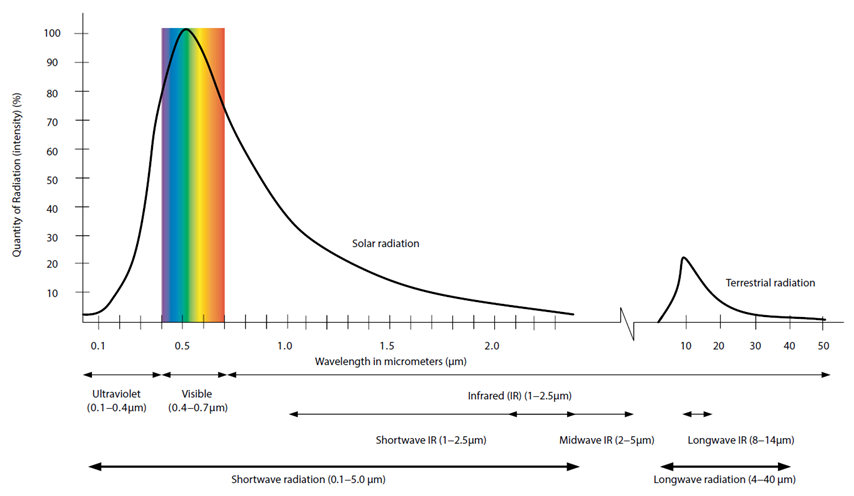
Svojstva propuštanja zračenja većine građevinskih materijala značajno se razlikuju u zavisnosti od talasne dužine. Na primer, standardno staklo je skoro propusno za kratkotalasno zračenje, ali je gotovo nepropusno za dugotalasno zračenje. Iz tog razloga, kratkotalasno zračenje je dominantna komponenta ukupnog zračnog prenosa kroz ostakljene elemente. Kratkotalasno zračenje emituje direktno sunce i ili direktno stiže do stakla (otuda direktno zračenje) ili se raspršuje na oblacima i atmosferskim česticama (koje se naziva difuzno zračenje). Kratkotalasno zračenje se takođe može odbiti od tla na ostakljenu površinu u zavisnosti od površinske refleksije ispred prozora.
The radiation transmittance properties of most building materials vary significantly depending on the wavelength. For example, standard glass is almost transparent to shortwave radiation but is nearly opaque to longwave radiation. For this reason, shortwave radiation is the dominant component of the total radiation transfer through glazed elements. Shortwave radiation is emitted by the direct sun and either directly reaches the glass (hence direct radiation) or is scattered by clouds and atmospheric particles (called diffuse radiation). Shortwave radiation can also be reflected from the ground to the glazed surface depending on the surface reflection in front of the window.
Dugotalasno zračenje često se opisuje kao odlazno zračenje koje napušta spoljnu površinu zgrade i zrači prema nebu i drugim objektima. To je zato što je dugotalasna komponenta dolazećeg sunčevog zračenja skoro zanemarljiva u poređenju sa dugotalasnim zračenjem koje emituju zemaljski izvori. Iako je apsolutna temperatura sunčeve površine približno 5.800K, efektivna temperatura neba (aproksimacija temperature zračenja površine gornje atmosfere) reguliše brzinu dugotalasnog prenosa toplote između neba i zemaljskih komponenti zgrade. Efektivna temperatura neba nije konstantna, već zavisi od vedrine neba (tj. oblačnog pokrivača) i varira na sinusoidni način tokom godine (najtoplije je u letnjim mesecima). Za vreme vedrih noći, čak i tokom letnjih meseci (u srednjoj i severnoj Evropi), efektivna temperatura neba može biti hladnija od temperature spoljne zgrade, a tokom ovih perioda dugotalasno zračenje će se širiti prema svemiru. Kao rezultat, temperature spoljne površine zastakljenih i neprozirnih komponenti sa neometanim „pogledom na nebo“ mogu padati znatno ispod temperature spoljnog vazduha u vedrim noćima.
Longwave radiation is often described as outgoing radiation that leaves the exterior surface of the building and radiates towards the sky and other objects. This is because the longwave component of incoming solar radiation is almost negligible compared to the longwave radiation emitted by terrestrial sources. Although the absolute temperature of the sun's surface is approximately 5,800K, the effective temperature of the sky (an approximation of the radiative temperature of the upper atmosphere) regulates the rate of longwave heat transfer between the sky and the terrestrial components of the building. The effective temperature of the sky is not constant, but depends on the clarity of the sky (i.e., cloud cover) and varies in a sinusoidal manner throughout the year (it is warmest in the summer months). On clear nights, even during the summer months (in central and northern Europe), the effective temperature of the sky can be colder than the exterior building temperature, and during these periods longwave radiation will propagate towards space. As a result, the temperatures of the external surface of glazed and opaque components with an unobstructed "view of the sky" can drop significantly below the outside air temperature on clear nights.
Zahtevi za NZEB prozore
Requirements for NZEB Windows
U konceptu niskoenergetskih objekata, prozori su od velike važnosti kako bi se osigurao toplotni komfor. Prozori sa većim koeficijentom prolaza toplote (U-vrednost) rezultiraće povećanim prenosom toplote; ovo se može osetiti kao hladna površina kada dodirujete staklo u zimskom periodu i, obrnuto, kao topla površina tokom leta. Projektanti trebaju biti svesni da čak i vrlo dobar NZEB prozor (Uw-vrednost <0,8 W/m2K) ima otprilike pet do deset puta manji toplotni otpor u odnosu na zid NZEB (s tipičnim U-vrednostima od 0,08 W/ m2K do 0,15 W/m2K). Prozori se stoga moraju koristiti mudro.
In the concept of low-energy buildings, windows are of great importance in ensuring thermal comfort. Windows with higher heat transfer coefficients (U-value) will result in increased heat transfer; this can be felt as a cold surface when touching the glass in winter and, conversely, as a warm surface during summer. Designers need to be aware that even a very good NZEB window (Uw-value <0.8 W/m2K) has roughly five to ten times less thermal resistance compared to an NZEB wall (with typical U-values from 0.08 W/ m2K to 0.15 W/m2K). Therefore, windows must be used wisely.
Asimetrično temperaturno zračenje igra važnu ulogu u udobnosti korisnika. Za ljude je neprijatno ako predmeti istovremeno zrače različite temperature prema našem telu. Prozor je važan u tom pogledu, jer ovde se mogu pojaviti najhladnije, ali i neke od najtoplijih temperatura zračenja u zgradi.
Asymmetric temperature radiation plays an important role in user comfort. It is uncomfortable for people if objects simultaneously radiate different temperatures towards our bodies. The window is important in this regard, as it can exhibit some of the coldest, but also some of the warmest, radiative temperatures in a building.
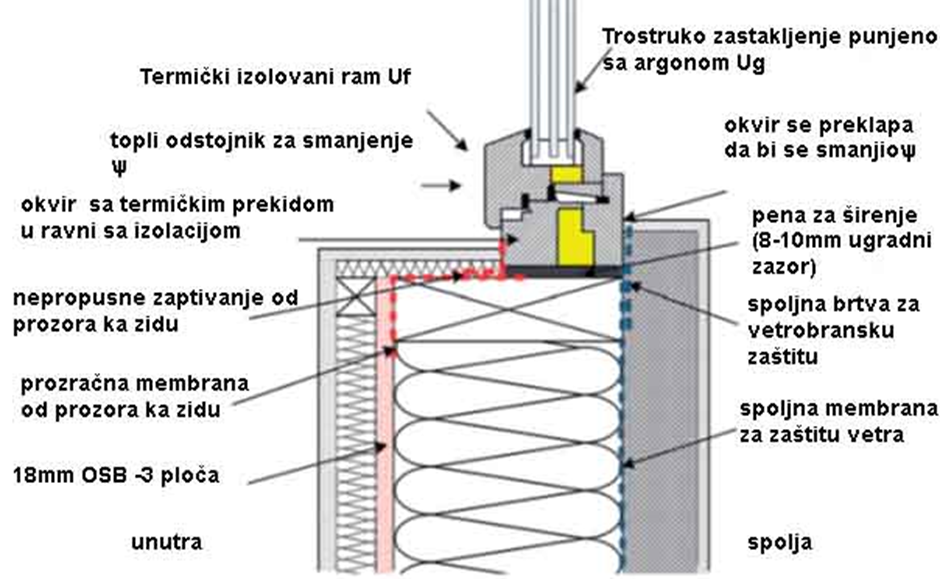
Karakteristike pravilno ugrađenog NZEB prozora sa U vrednostima ≤ 0,85 W/ (m²K), što garantuje visoki toplotni komfor i uštedu energije. Koeficijent prolaza toplote NZEB prozora je ograničen na maksimalnu Uw vrednost od 0,8 W/m²K ili, kada je ugrađen, Uw (inst) od 0,85 W/m²K. Ovaj kriterijum pruža zaštitu da temperatura unutrašnje površine prozora ne padne ispod 17°C, čak i kada je spoljna temperatura –10 ° C.
Characteristics of a properly installed NZEB window with U-values ≤ 0.85 W/ (m²K), which guarantees high thermal comfort and energy savings. The heat transfer coefficient of the NZEB window is limited to a maximum Uw value of 0.8 W/m²K or, when installed, Uw (inst) of 0.85 W/m²K. This criterion ensures that the temperature of the inner window surface does not drop below 17°C, even when the outside temperature is –10 °C.
Dobra ugradnja prozora je od velike važnosti. Uz obraćanje pažnje prema detaljima, moguće je skoro u potpunosti ukloniti toplotni most uzrokovan ugradnjom. Ovo je značajno s obzirom da je ukupna dužina oko oboda svakog prozora obično vrlo velika, a zbir svih ovih mostova u suprotnom može imati značajan uticaj na energetske potrebe objekta.
Good window installation is of great importance. With attention to detail, it is possible to almost completely eliminate the thermal bridge caused by installation. This is significant considering that the total length around the perimeter of each window is usually very large, and the sum of all these bridges can otherwise have a significant impact on the energy needs of the building.